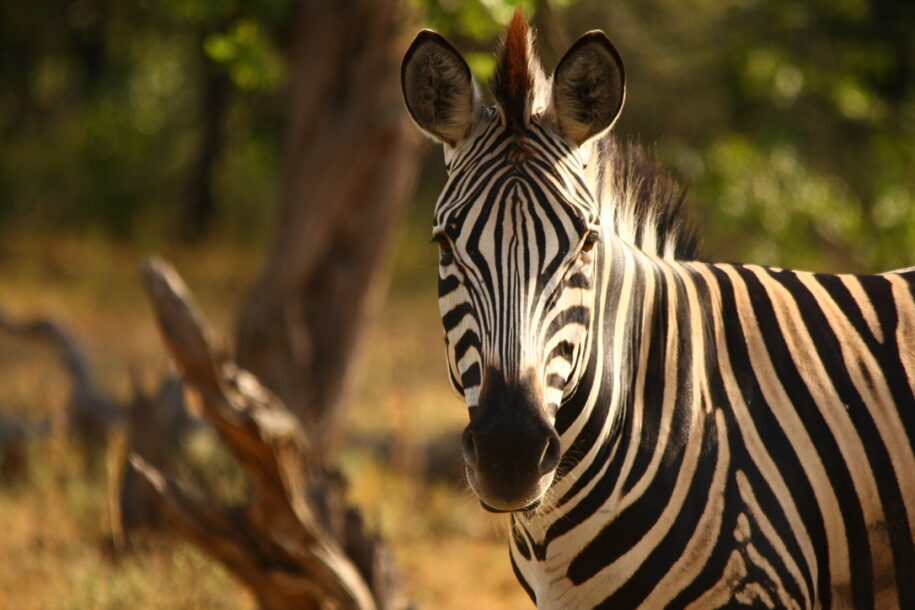Nature’s Striped Enigma
Few animals embody the wild beauty of Africa quite like the zebra. With their unmistakable black-and-white stripes, zebras have fascinated scientists, storytellers, and safari-goers alike for centuries. Yet, beyond their striking coats, zebras are complex animals with intricate social structures, survival strategies, and ecological roles that make them one of the most captivating creatures of the savannah.
In this blog, we’ll explore the dynamics and characteristics of zebras, from their physical traits to their social behaviours, survival tactics, and place in the African ecosystem.
Physical Characteristics
The most iconic feature of a zebra is, of course, its stripes. Each zebra has a unique stripe pattern, much like a human fingerprint. Contrary to common belief, zebras are not simply “white with black stripes.” Most evidence suggests that zebras are black-skinned with white stripes layered on top. The exact purpose of their stripes has long been debated. While camouflage was once considered the primary explanation, recent studies suggest the stripes may serve multiple purposes: deterring biting flies, confusing predators during a chase, and even helping with social bonding among herds.
Zebras are medium-sized equids, closely related to horses and donkeys. They typically stand about 1.2 to 1.5 meters at the shoulder and weigh between 250 and 450 kilograms depending on the species. Three main species exist: the Plains zebra (Equus quagga), which is the most widespread; the Mountain zebra (Equus zebra), found in southern Africa; and the Grevy’s zebra (Equus grevyi), which is larger, rarer, and distinguished by narrower stripes and a white belly.
Social Structure and Herd Dynamics
Zebras are highly social animals, relying on group dynamics for survival. Their social systems differ slightly depending on the species, but all zebras thrive in the safety and cooperation of herds.
Plains zebras typically live in stable family units called harems, led by a dominant stallion who guards several mares and their young. These harems often come together to form larger herds, creating a dynamic, shifting community on the move. In contrast, Grevy’s zebras are less tightly bound, with males holding territories and females moving more freely between them.
Living in groups offers many benefits, including protection from predators, cooperative care of young, and enhanced foraging opportunities. Within herds, zebras form strong bonds, particularly between mothers and foals. Grooming rituals—where zebras nibble and scratch each other’s necks and backs—help strengthen these bonds and reduce tension.
Survival Strategies and Predator Evasion
The African savannah is full of predators, from lions and hyenas to wild dogs and leopards, and zebras are a prime target. To survive, zebras rely on several key strategies.
Firstly, their stripes create a “motion dazzle” effect when the herd moves together, making it difficult for predators to single out one animal. Secondly, zebras have excellent eyesight and hearing, often acting as an early warning system for other grazers like wildebeest. When threatened, zebras will bunch together tightly, placing foals in the centre while adults face outward, ready to kick or bite if predators approach.
Perhaps most impressively, zebras are formidable runners. They can reach speeds of up to 65 kilometres per hour and sustain strong bursts of stamina. Unlike some antelopes, zebras also fight back when cornered. A zebra’s powerful kick is strong enough to break a lion’s jaw—a deterrent predators take seriously.
Feeding Habits and Ecological Role
Zebras are herbivores, feeding almost exclusively on grasses. Their teeth are perfectly adapted for grazing, with high-crowned molars that grind tough grass blades efficiently. Because zebras can subsist on lower-quality grasses that many other herbivores avoid, they play a crucial ecological role. By grazing down old, coarse grasses, they pave the way for more selective feeders like wildebeest and gazelles to access fresh shoots.
This grazing dynamic highlights the zebra’s role as a keystone species—one that helps maintain the balance of its ecosystem. Without zebras, grasslands might become overgrown with unpalatable grasses, disrupting the delicate balance that sustains Africa’s great herds.
Communication and Intelligence
Zebras are highly communicative animals, using vocalisations, body language, and facial expressions to convey information. They bray, snort, and whinny to warn of danger, maintain contact, or express frustration. A common display is the “ears back, teeth bared” expression, signalling aggression or dominance.
Their intelligence is often underestimated. Zebras are quick to learn migration routes, waterhole locations, and predator strategies. This adaptability is particularly evident during migrations, where thousands of zebras travel together across hundreds of kilometres in search of water and grazing lands.
Threats and Conservation
Despite their adaptability, zebras face significant threats. Habitat loss due to agriculture and human settlement is one of the biggest challenges. In addition, they are hunted for their skins and, in some regions, for meat. The Grevy’s zebra, in particular, is endangered, with fewer than 3,000 individuals remaining in the wild.
Conservation efforts, including protected areas, anti-poaching patrols, and community-based initiatives, have helped safeguard zebra populations in parts of Africa. Still, continued vigilance is needed to ensure these animals remain a vital part of the continent’s landscapes.
A Symbol of Wild Freedom
Beyond their biological and ecological significance, zebras hold symbolic power. Their stripes have inspired art, fashion, and folklore across the world. In Africa, zebras are often seen as symbols of harmony, balance, and free-spiritedness—creatures that embody both beauty and resilience.
Conclusion
The zebra is more than just a strikingly patterned grazer on the African plains. It is a highly social, intelligent, and adaptable animal that plays a critical role in its ecosystem. From their unique stripes to their herd dynamics, survival strategies, and symbolic meaning, zebras remain one of nature’s most fascinating enigmas.
To watch a herd of zebras move gracefully across the savannah is to witness the delicate interplay of beauty, survival, and community—a reminder of the richness of Africa’s wildlife and the importance of protecting it for generations to come.

